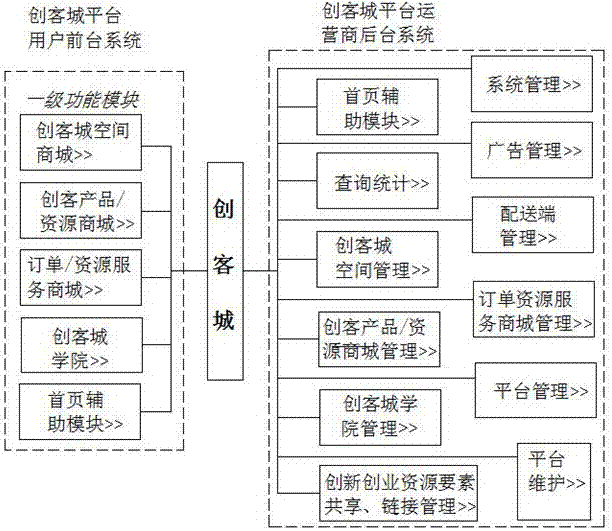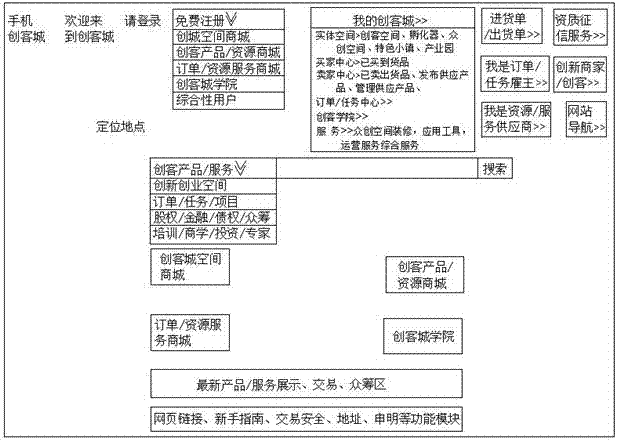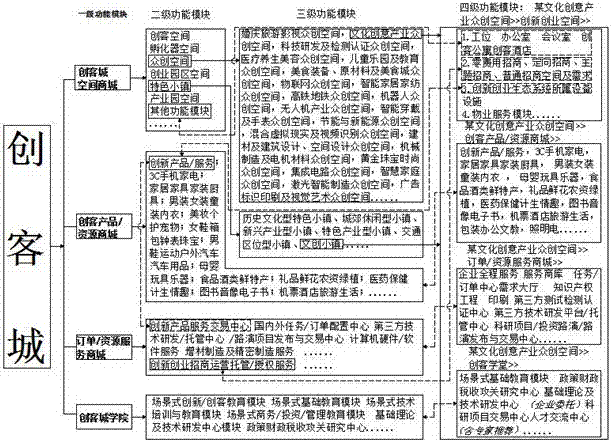[0008] 1. Makerspaces and makerspaces in my country are still in the early stages of development. Most makerspaces and makerspaces only provide venues and equipment for some simple innovations and inventions, and there are few professional guidance for entrepreneurship Resources cannot better serve college students and other innovation and entrepreneurship needs; many existing makerspaces and makerspaces only have limited offline resources, and there are few services or transactions involved online
It cannot directly and efficiently bring benefits to more makers, resource service providers, investors, etc.
Some makerspaces are struggling to develop themselves. Maker culture has not yet been widely recognized and respected. The role and influence of promoting economic development, creating an innovative culture, and driving self-employment are still very limited. It is difficult for innovation and entrepreneurship to succeed
[0009] 2. Entrepreneurship is a lonely and arduous process. In this process, entrepreneurs will encounter many unpredictable problems and their confidence will be severely tested.
The targeted entrepreneurial counseling provided by tutors in makerspaces and makerspaces can provide entrepreneurs with practical advice, help them survive the difficult period of entrepreneurship, and help improve the success rate of innovation and entrepreneurship; however, most of the current makerspaces, Maker Space has not formed a mentor resource and mechanism that can truly help, and start-up makers / enterprises do not have spare funds to hire these mentors and introduce a mentor resource mechanism at low cost
[0010] 3. The business models of Makerspace and Makerspace are composed of many elements, and a complete business
model system has not been formed at present; Makerspace and Makerspace have not yet formed a complete and mature business operation
technology system. Makerspace Resources are limited and relatively single, unable to meet the
entire life cycle of the design and manufacturing service industry, and unable to fully integrate various
online and offline design service resources to serve innovative design and manufacturing; and also fail to form a market for innovation and entrepreneurship overflow opportunities, such as "accidental entrepreneurship" These problems are due to the lack of effective organization and operation from the technical point of view, resulting in low efficiency and low success rate of innovation and entrepreneurship
[0011] 4. At present, various types of innovation and entrepreneurship space carriers such as: incubators, maker spaces, maker spaces, industrial parks, economic and technological development zones, etc. have serious homogeneous competition, and have not formed a set of carrier technology optimization and carrier space for innovation and entrepreneurship space. The content of innovation and entrepreneurship fills the means of operation technology, resulting in a large number of entrepreneurship space carriers, which seriously reduces the utilization efficiency of innovation and entrepreneurship resources in the whole society. There are more than makerspaces, there are not enough makers, and thousands of gardens are seriously
wasting resources for innovation and entrepreneurship, which is a loss to individuals and society
[0012] 5. Element resources based on innovation and entrepreneurship such as: office space, talents, capital, technology, equipment raw materials, technical services and other elements of innovation and entrepreneurship resources are not scattered and orderly, and there is no efficient collection of various innovation and entrepreneurship resources A comprehensive platform for terminal
consumer products / services after the fusion,
fission, and qualitative change of element resources and output of higher value innovation and entrepreneurship element resources
[0013] 6. The innovation and entrepreneurship element resources in the various entrepreneurial space carriers mentioned above are isolated and exist at a
single point, and there is no organic connection and / or
breakpoint between the innovation and entrepreneurship element resources, between upstream and downstream elements, and between horizontal element resources; Form an innovation and entrepreneurship
ecosystem[0014] 7. The cultural
atmosphere of innovation and entrepreneurship and the resources of elements of innovation and entrepreneurship have not formed a trust platform for the allocation of resources of elements of opportunity, innovation and entrepreneurship, the cost of communication and trust is high, the
atmosphere of entrepreneurship and innovation culture is not strong, etc., and the existing resources of elements of innovation and entrepreneurship have not been fully tapped Utilization, conversion, conversion efficiency
[0015] 8. Most of the various entrepreneurial space carriers, especially those with poor geographical locations, lack the filling of industry and entrepreneurial content; the above-mentioned part of the entrepreneurial space carriers is still at the level of property service level, that is, basically they still use first-hand landlords or second-hand housing East management and
operation mode, failed to provide in-depth and professional innovation and entrepreneurship services for industries, industry content, and innovative entrepreneurs, and failed to make full use of the existing value of innovative and entrepreneurial elements and resources
[0016] 9. Funding problems faced by innovation and entrepreneurship. The
primary problem facing innovation and entrepreneurship is the problem of funds. Because a large number of start-ups are small and micro enterprises, they cannot obtain loans and support from financial institutions such as large state-owned banks, local banks, trust agencies, and guarantee agencies. 99% of many start-ups died within a year, and many of them died of high-tech companies with good growth potential, which was essentially a waste of social resources; because the financial environment and financial support were not effective. It has benefited a large number of small, medium and micro enterprises, resulting in low efficiency of innovation and entrepreneurship in the whole society, low success rate of entrepreneurship, and few job creations
[0017] 10. The talent problem faced by innovation and entrepreneurship. The current education system and environment are all centered on exam-oriented education. Under the baton of exam-oriented education, it is difficult to cultivate high-end technical and management talents suitable for innovation and entrepreneurship. In terms of structure and type, it deviates from the requirements of innovation and entrepreneurship; and the ultimate strength of social development and progress is still driven by these innovative and entrepreneurial talents
Secondly, the existing education methods and methods also have serious current problems such as the disproportion between input and output, and the mismatch between input and output. The current education and
training methods basically remain in the industrialization, factoryization, and
assembly line This education method is incompatible with the talent requirements for the future development of the experience economy and customized economy; at present, there is a lack of educational environment for maker education,
personalized education, and experiential education, as well as
software and hardware facilities.
[0018] 11. Another big problem facing innovation and entrepreneurship is the problem of product sales. Since most of the targets of innovation and entrepreneurship are small, medium and micro enterprises, the start itself is very difficult. Funds and talents are very limited, and there are not many resources to develop markets for product sales. , Furthermore, due to the poor
credit system and credit environment in the current society, it is difficult to attract consumers who pay for consumption even if it is a product with good
cost performance. Undoubtedly, it has led to an increase in the cost pressure of innovation and entrepreneurship, and a further reduction in the efficiency and success rate of innovation and entrepreneurship;
[0019] Secondly, because the corresponding products on the existing various online sales malls / platforms do not have spatial location
traceability, resulting in the proliferation of counterfeit and shoddy products, which further reduces the quality of self-built or existing online sales malls / platforms. The degree of platform trust and the cost of communication trust are further infinitely magnified, which reduces the efficiency and success rate of innovation and entrepreneurship from the side
[0020] 12. The problem of experience economy and
sharing economy is the trend of future economic development, and it has already been reflected. The current social environment, credit environment, consumption environment, talent environment and other aspects are conducive to the promotion and establishment of experience economy,
sharing economy and production economy. (The economy of
symbiosis, sharing, and mutual prosperity between consumption and output) is still facing many problems. The existence of these problems undoubtedly leads to increased pressure on the cost of innovation and entrepreneurship, and further reduces the success rate of innovation and entrepreneurship.
[0021] 13. At present, all joint offices, shared offices, maker spaces, incubators, and maker spaces have more public service spaces (such as: public conference rooms, printing rooms, water bars, fitness areas, libraries, etc., resulting in In terms of
space planning, it will increase the cost of innovation and entrepreneurship for the settled enterprises, which also violates the principle of co-working, shared office, maker space,
incubator, and maker space. The original intention of providing low-cost innovation and entrepreneurship space is contrary to the original intention, and it is urgent to carry out technology planning and construction, innovation and entrepreneurship facilities, etc. Improvement, thereby reducing the cost of innovation and entrepreneurship, and improving the efficiency and success rate of innovation and entrepreneurship
 Login to View More
Login to View More  Login to View More
Login to View More 


